Now Booking Hunts for Future Years
>>> At this time, we are not booking ocellated turkey hunts in Guatemala. The last hunts were in 2009. <<<
Click here for pricing, dates, and other ocellated turkey hunting information.
About the Ocellated Turkey Conservation Program
The ocellated turkey is in decline in much of its historic range of the Yucatan region–an area about the size of Florida. Although we promote hunting, our sights are on conservation of the ocellated turkey. Our program, supported by the National Wild Turkey Federation and the Wildlife Conservation Society, is designed to show the local subsistence hunters that they have a valuable resource in the ocellated turkey—it can be the "goose that lays golden eggs" if they manage the populations properly primarily through conservative harvest management practices. We give the local community over half the proceeds and the villagers love our program. We believe that the turkey populations where we hunt have reversed course and are now on the increase. It seems easier every year to maintain our 100% hunter success rate.
Come join us for a great and adventurous hunt with a conservation objective.

The
morning’s take
Regulated harvest is the key. If the harvest is restricted to adult male turkeys in spring hunting, as we are now demonstrating, the productivity of the population will be stable and the ocellated turkey will remain a significant economic asset to the communities. The Guatemalan government is in agreement and is cooperating by issuing export licenses for the skins and in other ways.

Our
Project Manager Erick Baur, an American graduate student living in Guatemala,
examining a specimen
A Brief History of the Ocellated Turkey Program
The hunts scheduled for 2010. The 2010 hunts had be cancelled because the communities can't make a profit with fewer than 12 hunters. We will have hunts in 2011.
The hunts in 2009. We continued to use both the Uaxactun and Carmelita camps in 2009. The third hunt at Carmelita was out of a new camp. All hunters took a trophy and most took a second trophy. Most of the hunts finished a day early. Two more turkeys with double spurs were taken. The calling method continues to be an exciting and effective way to get a trophy.
The hunts in 2008. We had 35 hunters for the hunts at Uaxactun and Carmelita and the clients were 100% successful again. Twenty-seven hunters took 2 trophies for a total of 62 trophies taken. Four of the trophies had spurs exceeding 2 inches and we got another double-spurred trophy and the 12.5-pound trophy is the heaviest yet for Guatemala. The electronic callers continued to perform well and most hunts were concluded in 3 days.
The hunts in 2008. We had 35 hunters for the hunts at Uaxactun and Carmelita and were 100% successful again. Twenty-three of the hunters took 2 trophies. Four of the trophies had spurs exceeding 2 inches and we got another double-spurred trophy. The electronic callers continued to perform well and most of the hunts were concluded in 3 days.
The third hunt at Carmelita was out of a new camp. We will continue to use both Carmelita camps in 2009. All 35 hunters at Uaxactun and Carmelita took a trophy and most took a second trophy. Most of the hunts finished a day early. A total of 62 trophies were taken. A lot of trophies were left singing in the jungle for next season.
Two more turkeys with double spurs were taken and the 12.5-pound trophy taken in 2008 is the heaviest yet for Guatemala. The calling method continues to be an exciting and effective way to get a trophy. We are working on an instrument to manually imitate the drumming call which may be an even more effective calling method than the song we now use. Stay tuned.

The new Carmelita camp
is called Buena Vista, Spanish for "Beautiful view." It is on
a small lake.
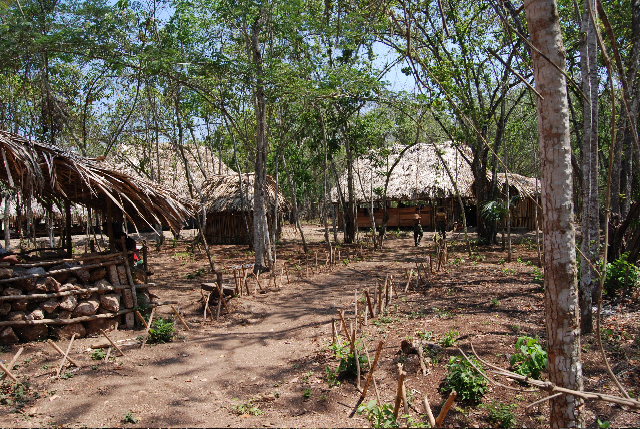
The Buena Vista camp
at Carmelita (for the 3rd hunt) was constructed several years ago as a
recreational area
for the local residents from another nearby village. The area is seldom
hunted.
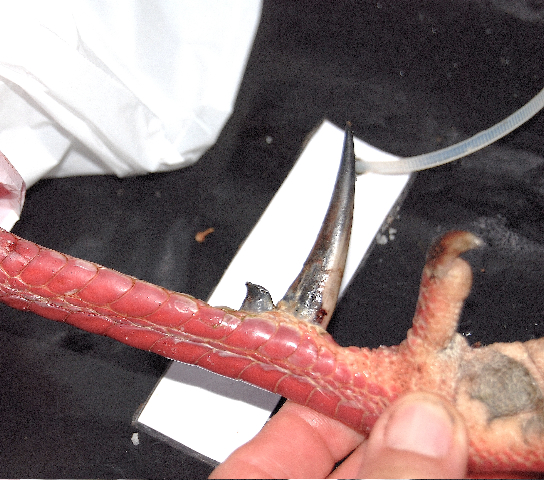
A turkey with a double
spur--the third we have taken out of 244 adult male specimens.
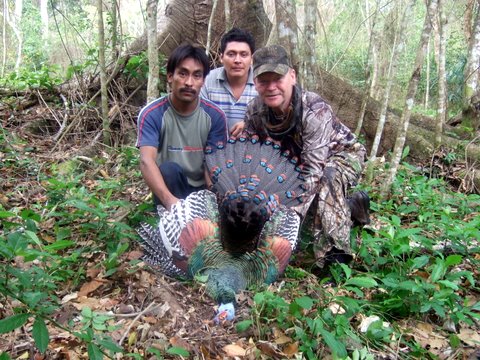
A client, his trophy,
and his guide and his scout.
The hunts in 2007. The hunts at Uaxactun and Carmelita were again 100% successful. All 5 hunts ended by the third day which permitted the hunters to visit the Mayan ruins at Tikal National Park without lengthening their stay. Thirty hunters took 50 trophy ocellated turkeys one of which had an extra spur on one leg. That's the first double-spurred ocellated turkey I have heard of. The electronic callers continued to perform well although a few turkeys did not respond promptly (which is no news to any experienced turkey hunter). The spurs on several turkeys exceeded 2 inches. Footage for a one-hour video program was shot by the NWTF that will appear on TV later in the year. The turkey in the video kill scene had spurs of 2-3/16 and 2-1/4 inches--a record for the hunts so far.
The harvest level has steadily increased each year which we hope is a sign that the very important conservation aspect of the program is paying off. The guides and other personnel that build the camps and work the hunts are reaping the benefits of proper harvest management of the ocellated turkey population in the hunting zone. We are adding a third hunt at Carmelita which will permit us to accommodate a total of 35 hunters in both camps in 2008.
The hunts in April 2006. The hunts were a great adventure for all and continued our 100% success rate from the beginning of the program. We increased the number of hunters to 27 in 2006 and permitted 20 hunters to take 2 turkeys for a trophy fee. Everybody scored including all those who opted for a second bird—for a total of 47 adult male turkeys taken. Again there were a few 2+ inch long spurs and all 47 will be beautiful trophies.
The electronic play-back callers are working well. The hunters who preferred to call in their birds were successful in doing so.
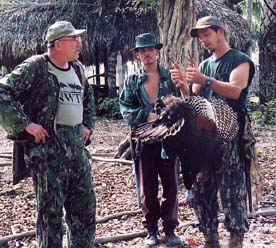
Hunt Director Erick Baur Examines a Trophy
The hunts in April 2005. The most recent hunts were 100% successful as every hunt has been since the program began. The 23 hunters took 36 adult male turkeys and left plenty for next year. Every hunter who opted for a second turkey got one. Most turkeys were called in with our new calling device. Several spurs exceeded 2 inches and one spur was 2 1/4 inches—believed to be as long as any on record.
The new callers worked well. In many cases turkeys responded to the caller immediately after flying down from the roost. Nearly all the hunters had their trophies by the second hunt day.
The hunts in 2004. In April 2004 we had 12 hunters at Uaxactun and 8 in our new camp 30 miles west near the village of Carmelita. We were 100% successful in both camps. One hunter had to take a second bird because the first one had been badly damaged, and biologist Neal Eichholz, who has assisted in development of a calling method, took his first ocellated turkey—using the caller, of course. In all, 22 adult male turkeys were taken.
One of the highlights of the 2004 season was the outstanding success with the new calling devices. On one hunt, all 5 hunters called in and shot their bird before 7:30 a.m. on the first day of the hunt. Read more about the calling method.
The hunts in 2003. This would be our third hunt and again all hunters got their turkeys. The weather was dryer than usual, which seemed to curtail adult male singing somewhat, but the guides were able to roost turkeys every evening for the hunters.

World
War II fighter pilot ace Col. James Morehead posed in uniform at our request.
The Col. Proved once more that he can still shoot straight.

Another
limb hanger
Because of the curtailed singing (=gobbling) behavior in 2003 we did not discourage roost shooting. The calling method was not yet fully perfected and we wanted to be sure everybody got their bird. We had already discontinued using spot lights in the dark because of the high probability of mistaken sex ID and the difficulty of finding a crippled turkey in the darkness.
Roost shooting has a few drawbacks. If you don't get your trophy during the first few minutes of dawn, you have to wait until evening roosting time for your next hunt. When you do roost shoot, the fall from the roosting tree sometimes damages the specimen's plumage unduly necessitating the taking of another specimen so that the hunter has a suitable trophy. With an effective calling technique, a hunter can approach a singing male on the morning roost, set up for calling, positively identify him as an adult male by his singing and interest in the call, and call him in for a close shot. If unsuccessful at flying down time, the hunter can remain in the woods, continue to call and hunt in a style similar to the way we hunt turkeys in North America. We have given development and testing of a calling method very high priority.
 |
|
 |
 |
 |
 |
Scenes from the 2003 hunt
In 2003, Lovett used the "ocellated turkey clucker" to call in a trophy with spurs exceeding 2 inches taken by Michael Tull of Roswell, Georgia. Michael's hunt was videoed by Jason Marrow of the National Wild Turkey Federation for a NWTF television program. The following day, one of the guides who had worked closely with Lovett on the calling trials with the “clucker” called in a trophy for hunter Bud Smedley of West Milton, Ohio in mid-morning. Bud was so pleased that he gave the guide a big tip which, needless to say, made the guide wealthier and greatly heightened interest by the other guides in learning how to call in turkeys.
We closed out the hunts in 2003 with 100% success and with some satisfaction that turkeys could be called in with the owl hooter used for the ocellated turkey’s clucking call.

The
2 1/8 inch spur is enough to put this old bird in the record book

Weighed,
measured, and ready for the skinning table
In the April 2002 hunts all the hunters got their trophies and we took an extra specimen to be prepared as a skeleton for the NWTF museum in Edgefield, South Carolina. Both hunts ended successfully by the second morning. One adult male had spurs pushing two inches, some exceeded 1 3/4 and none was less than 1 1/2 inches. Body weights ranged from 11 to over 12 pounds.
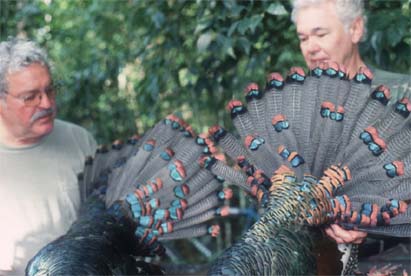
Two Successful Hunters in 2002
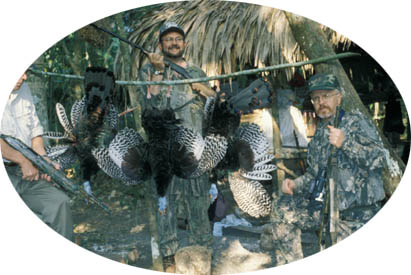
More
Hunters with Ocellated Turkeys
April 2001 hunts. This was our first full-fledged hunt and our 8 American hunters were 113% successful--one had to take a second adult male because his first one was shot up too badly. The guides sometimes get the hunters very close—sometimes too close and we learned on the first hunt.
In April 2000 we had the okay of the Guatemalan government to hold the hunts but needed to test a few things before booking paid hunters. In early April Lovett spent a few days in the newly built camp in the jungle north of the village of Uaxactun, had a companion shoot a male turkey, instructed the guides on skinning procedures for taxidermy, and tested the export process by bringing the skin into the U.S. with a CITES certificate issued by the Guatemalan government. The turkey, a jake, is now in the National Wild Turkey Federation museum in Edgefield. We found everything ready for launching the first full-fledged hunts in 2001.
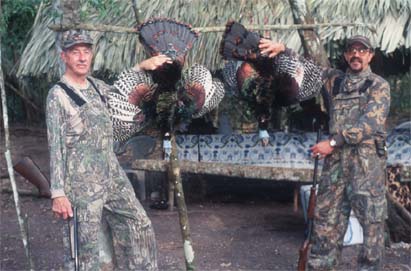
Hunters Back from the Morning Hunt
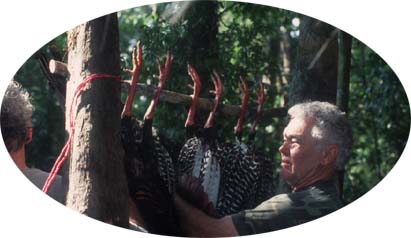
Limb Hangers Fresh from the Jungle
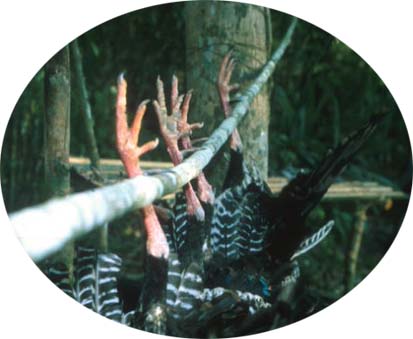
Limb
Hangers All
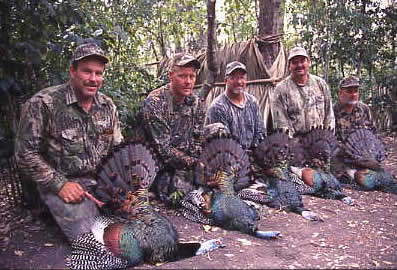
Five hunters that called in
their trophies.

A sleeping hut at Uaxactun.
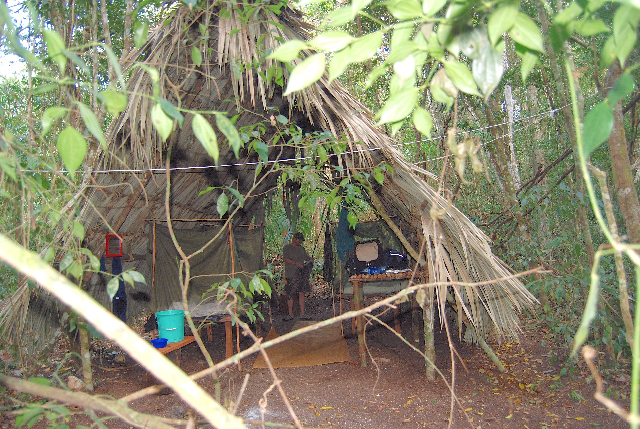
Sleeping hut at Carmelita.
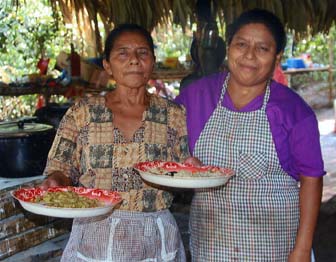
Your "Cocineras" Await You with "Comida Tipica."
>>> At this time, we are not booking ocellated turkey hunts in Guatemala. The last hunts were in 2009. <<<